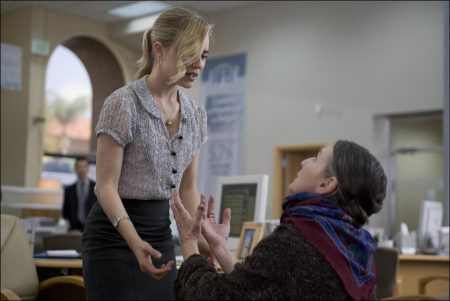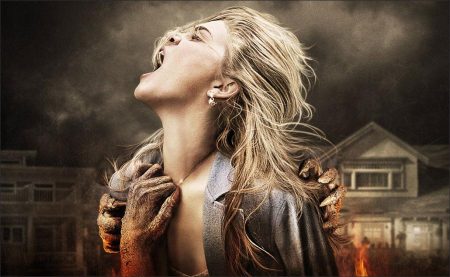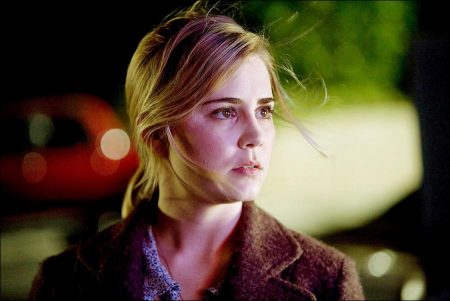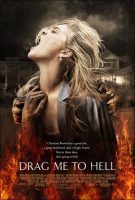Creating Scares: Effects, Stunts, Makeup and Puppetry
Drag Me to Hell Movie Trailer. The many frights and jumps in Drag Me to Hell are the end product of everything from green screen, puppets and prosthetics to creative man-made props and CGI. Raimi’s imaginative behind-the-scenes team includes alums from his previous films and other artisans well versed in the world of horror and gore.
Traditional Effects
Director of photography Peter Deming, who previously worked with Raimi on Evil Dead 2: Dead by Dawn and served as DP on the last two Scream films and From Hell, used realistic lighting in his shoots that goes progressively darker as Christine is drawn further into the world of the supernatural.
Says Deming of the process: “We went with a lot of source lighting and didn’t correct the odd lighting sources, like in the garage where everything is blue-green. Normally, you’d put all corrected bulbs in, but we went with what was there, including the shots in the street. We used the streetlight look and mixed that with interior lighting. There were a lot of odd color sources that we chose to leave the way they would be naturally. It’s a heightened sense of realism.”
For the séance scene, which has a richer color palette, the cinematographer used additional lighting effects and camera shakes to increase the feeling of anxiety and tension as the viewer begins to believe Christine has no way out.
Deming also took part in creating the atmospheric elements for scenes involving the Lamia, which included reflecting light against shaking Mylar and capturing the unnatural wind that blew leaves down the street. “Sam loves B-movie stuff,” Deming says of the high-impact elements. “He really embraces the wind out of nowhere and the camera shaking and the inventive, interactive lighting. He eats that up.”
The DP made a concerted effort to adhere to the script’s focus on the audience’s relationship with Christine. “From the beginning, Sam and I talked about being with her as much as we subjectively could throughout the film,” he offers. “We stayed right on Alison’s face a lot of the time. We covered scenes and gave her extra-tight close-ups, because we want the audience to be in her place.”
One of the first projects the special effects teams tackled was deciphering how to shoot Mrs. Ganush’s attack on Christine in Christine’s car. In order to film the action, which includes close-ups of Christine jamming her foot on the pedal, hitting the brake and shifting gears, the team created a puzzle car. Their design allowed for the front engine compartment and back trunk-as well as all four sides and doors-to come away from the car. The roof came off in two directions (front to back and side to side), which-despite the tight space-gave the filmmakers a good deal of freedom to shoot from different angles.
Commends Deming of the design team’s work: “There’s no way we could have shot that scene without that car. During preproduction, we went through every shot and figured out what part of the car had to be off and what part of the car had to be on. They sliced up the car according to those shots, and it worked amazingly well. The car was able to be taken apart and put together very quickly.”
Greg Nicotero and Howard Berger, the partners at KNB EFX Group who supervised the special makeup effects, have collaborated with Raimi on several of his films. Nicotero and Berger met the director in 1986 on Evil Dead 2 and also collaborated with him on Army of Darkness. When he learned of the project, Nicotero was happy to hear that the film would be using a great deal of traditional effects. “Visual effects are fun, but there’s just something about a bunch of guys pulling cables and moving a puppet around,” he laughs. “Sam is still enamored with that.”
Unlike with several of his past horror films, Raimi did not want this one to be strictly driven by gore. Of the decision, Raimi explains: “I didn’t want to do exactly the same thing I had done before. This time, I didn’t want to have a lot of blood.”
The special effects teams used a wide array of tricks throughout filming Drag Me to Hell. For example, to create Mrs. Ganush’s malevolent floating handkerchief, the team attached the material by four wires to a fishing pole; with the help of a little wind, they then fluttered it around and flapped it toward the source of the curse.
When shooting the driving sequence in which Christine drives manically across town, the handkerchief traveled at 35 mph. Similar to a kite, it was hung on two wires in the direction the car moved, and the material was turned to move in and out of the car when placed in just the right spot.
To create the wind effects in Christine’s Silver Lake apartment (a sign that the dreaded Lamia is approaching), the team used monofilament to open and close doors and move chandeliers and curtains. The craftspeople ran copper tubing pipes through windows and blew air through them toward venetian blinds and curtains.
Stunt Work
Some of the actors faced the challenge of doing portions of their stunt work, including Lohman and Raver when their characters fight in the puzzle car. Raimi remained impressed by his leads’ focus on details and his crew’s adherence to strict safety with the scene.
“Randy was very careful with them,” he notes. “He ran rehearsals for the actresses with his stunt ladies first…so Alison and Lorna could see exactly how the scene should be played out. Then the actresses came in and saw what was safe and what was unsafe, based on these demonstrations. Then they made it their own.”
Says Lohman of her fight scene with Raver: “In the beginning, Lorna and I said that we were allowed to just take it to the nth degree and hurt each other. We needed to, because the camera was so close that you really can tell if that person is in pain or not. So I would try to get Lorna to strangle me for a little while and hold my breath.”
Adds her on-screen antagonist: “The stunt people were great at showing us how to grab someone and how to make it look authentic. They instructed us on how to move so that it looks like you’ve been thrown in different directions.” Despite their attention to the choreography, there was the unavoidable mishap or two. “She clocked me one time with the stapler,” Raver winces. “Fortunately that stapler was not made out of real metal.”
Out of the picture car and back at Christine’s apartment, Lohman was strapped to wires to create the effect that the Lamia was yanking her off the floor and swinging her around her bedroom. The filmmakers took a week to rehearse the scene with a stunt double and then brought Lohman in for a day of shooting. Comments second unit director/stunt coordinator RANDY BECKMAN: “One of the biggest challenges was making sure that Alison was willing and able to do most of the stunts herself. She’s done a lot of falling; she did a lot of flying. She did a lot of hitting the ground and was a real trouper.”
For her part, Lohman knew what she had signed up for and took it in stride. She admits that her director’s attitude got her through the tougher days. “I really like Sam’s sensibility because he adds a sense of humor to everything,” Lohman reflects. “It’s very absurd and strange and funny, but dramatic at the same time.”
The séance scene in which Shaun San Dena attempts to trick the Lamia and dispatch of it for good also included wirework and fire effects. For the portal to another world, the construction team built a table with a ring and five pockets of propane encased within. KEVIN FOSTER as Shaun San Dena’s assistant, Milos, was covered in gel and, with computerized winches, floated over the table as it erupts in flames. Beckman’s team worked closely with special effects coordinator JIM SCHWALM to build the table and make sure it didn’t get too hot for Foster.
For the cemetery scene in which Christine unearths Mrs. Ganush’s grave to give back the gift that was bestowed upon her, Schwalm’s team built a steel tank in the shape of a triangle. The crew created dams so that it could adjust the height of the mud that was pumped into the tank; the team then proceeded to pour in muddy water from all three sides.
The mud, which was made of methylcellulose and Oreo-cookie dye, was pumped into the tank in increments throughout the sequence of the shot. That way, if the filmmakers wanted it up higher, Schwalm’s team could put in another dam and, on cue, fill in more mud. Rigging points were placed above Lohman so that she was able to move around freely, climb up and then fall and splash back into the watery grave.
Dragging Christine to Hell
One of the tasks that second unit director / visual effects supervisor BRUCE JONES and the mechanical effects team took on was the scene in which the Lamia is trying to pull Christine down into hell. To accomplish this, the crew built a hydraulic cylinder and two types of chairs for Lohman to sit and lie upon, put the green screen around her and lowered her into the cylinder.
Explains Jones: “The chairs were made of Lucite, which is clear, so that light could come through. The cylinder had a working space so that our KNB folks could be in green suits with prosthetic hands and physically have interaction with Alison. We filled in the hole with CG rocks and debris and added shooting-light beams.”
The team also used 3-D match moves (so it could add the railroad tracks in post-production), and the plaster staff made fake rubber rocks that looked similar to the size of the real rocks at the railroad tracks. The cylinder was filled with the rubber rocks, so that when Lohman was pulled through them, DP Deming could capture the illusion that she was being pulled through the ground…just as if it were quicksand.
When reflecting upon the female lead he put through hell and back with these intricate set-ups and stunts, Raimi has strong words of praise. He offers: “Alison was incredible. We hit her with fights, the mud and the blood, and she just came out a champion each and every time-ready for more. I was thrilled with her endurance and her professional quality throughout all these really tough sequences.”
Makeup
In one of the few sequences he and Ivan Raimi imagined that involves blood, Sam Raimi asked that Christine’s explosive bloody nose be done practically. To create the most extreme epistaxis ever caught on film, makeup artist Nicotero ran a tube behind Lohman’s ear, along her face and into her nose. His team built a small reservoir that glued into her nostril so that the blood would rebound off of a little plug and shoot outward. At one point, they were able to make the fluid shoot an astonishing distance of close to 12 feet.
“It was bizarre,” laughs Lohman about the bloody nose rig. “It’s this tube that is almost like a sprinkler in your nose, and then it turns on. The weirdest part was the pressure and the amount of blood that came through.”
Among KNB’s many contributions to Drag Me to Hell are the multiple incarnations of Mrs. Ganush. Their work includes the embalmed body Christine finds at the wake, the rotting corpse from the young bank loan officer’s nightmare and the “peacefully resting” body in the cemetery.
When you’re working with this many iterations of the dead, you have to have a gallows humor on set. “Sam has a specific way of referring to characters, and he has this sense of humor that’s very outrageous and over-the-top,” Nicotero explains. “I’ve spent enough time with him to know the boundary of Sam is pretty free. If you lead him down a path that feels a little outrageous, he’ll be happy to go there-because he wants to give the audience a good ride and wants to have a good time with them.”
In order for the makeup and SFX teams to create all of her character’s different looks, Raver had to spend a good deal of time in body and face casts. “Lorna is such a great actress and such a trouper,” Nicotero compliments. “Not only did we cast her face in multiple expressions, but we sent her to a company in Burbank called Cyber Effects. There, we scanned her from head to toe to create three-dimensional replicas of her body. We also scanned her in this wide-open mouth, super-crazy, heinous, horror hag expression.”
To add insult to injury, Raver was also fitted for multiple sets of dentures, a special contact lens and a prosthetic to show the results of her run-in with the business end of Christine’s office stapler.
The actress was relieved to find that the makeup wasn’t too prohibitive…though she admits she was nervous about having two life casts done. “I give all the credit in the world to Greg, Howard and the people at KNB, and Garrett and the people who worked on my makeup,” Raver notes. “They worked very carefully with me, and it was absolutely fascinating. I don’t have a lot of prosthetics…prior to the audience seeing the demon version of Mrs. Ganush. The makeup didn’t cover my face or inhibit my natural expressions. It’s just accentuating my wrinkles and deepening what’s there.”
In the horror film, Mrs. Ganush has a few moments where she appears as an apparition to Christine. For these instances, the makeup was exaggerated and embellished. Raver comments: “The demon makeup covers a lot more, but that was a different bit of acting. By that time, I’m really a fantasy figure in her mind. It’s what she is seeing, not what I’m acting. It’s not Mrs. Ganush. It’s Christine’s vision of Mrs. Ganush.”
Puppetry
KNB’s other duties included control over a mechanical goat that is featured in the séance sequence. While at Shaun San Dena’s, the Lamia manifests itself in some of those surrounding Christine, including the farm animal. “Sam and I talked about designing the Lamia like a creature character that was half goat and half man…with horns and a big prosthetic,” explains Nicotero. “We also talked about doing it as a suit and doing it as a puppet.”
Raimi decided that the Lamia should be an unseen force that is able to possess the bodies of the people and the goat at the séance. The KNB team took aspects of the goat theme and, to help show the demon inhabiting the characters, the crew used makeup effects that included contact lenses, widened noses and brows-as well as slits for eyes and sharp pointy teeth for the objects of possession.
At least one of the Raimis was stunned by the animatronic goat. “Greg loved to scare me,” Ivan Raimi laughs. “I walked into the séance room and, out of the corner of my eye, I saw that the goat was turning its head to follow me. When I turned to face it, it stopped.”
Nicotero, who also built a puppet of Bill Paxton for use in Sam Raimi’s A Simple Plan, admires his director’s love of puppeteering. “Sam has a real specific feel for puppeteers. He embraces the idea that there are performers that actually bring these characters to life. It’s not a matter of just showing up on set and pulling a couple cables. Sam understands that there is an art form to puppeteering; he’s one of the few directors I know that really embraces that.”
In admiration of Nicotero, Berger and their team’s creation of the many effects, Raimi concludes: “If you ask Greg or Howard for an effect, they know how to present you with options to give you the best illusion for that particular camera angle. They craft really original, frightening horror art. Then they take it to the set, get into the action with their puppeteers and perform with it.”
Designing Drag Me to Hell
Production for the horror film began on location in Tarzana, California, in a vacant former bank that was redesigned and dressed to become the Wilshire Pacific Bank. The muted, earth-toned setting that stood as Christine’s workplace was crafted by production designer Steve Saklad, who previously collaborated with Raimi as art director on Spider-Man 2.
Skewed angles, unusual points of view (both figuratively and literally) and a twisted sense of humor give Drag Me to Hell a unique feel. Surrounded by countless technical details, from the intricate sets to the inventive angles and the elaborate makeup gags, Raimi managed to devote his concentration to story, character and performance.
Set Design
Each of the spaces designed by Saklad showcased the ensuing drama. The bland palette of the bank is suddenly shocked with torrents of red; the richly exotic, ornate séance room hosts an otherworldly chain of events; and the graveyard provides a messy, gothic and claustrophobic setting for the climactic moments that occur six feet under. In order to achieve all of the tension and horror contained in the script, the production design department employed both existing locations and sets that were built from scratch.
“We created back stories for Rham Jas and Christine so that the rooms we offer them were filled with their family histories and lives before the moment we see them on screen,” offers Saklad. “For us, the only mistake we could make was if we didn’t make it real. Sam could be as wild as he wanted with his ideas for action sequences as long as we gave him a real world. As soon as you feel like that it’s a fake wall that they’re throwing that girl against, the gag doesn’t work. The more real we were, the more the horror can work.”
Form followed function when designing the sets for Christine’s bedroom and the séance room, which were both constructed on stages on the 20th Century Fox lot. Saklad designed the rooms with removable walls and ceilings and consulted with second unit director/stunt coordinator Randy Beckman about making the space stunt-player-friendly.
Saklad explains: “During the month before we finished building the set, the stunt coordinator was rehearsing the flying stunts. Randy found in those rehearsals where he was going to need to poke holes in the walls to allow wire control. The design of the ceiling was planned very early in the process, and the rehearsals confirmed which pieces of the ceiling would move away for which gag.”
Once the séance room was constructed, set decorator DON DIERS filled the space with weathered, exotic objects. The space had to have the look of a 30-year dormancy. “We took thrift-store books and died them so it looks like they sat here for 40 years,” Diers notes. “We found antique furniture that we shredded with wire brushes. We came up with Moroccan-type benches, and I had the upholsterer take big handfuls of the stuffing out of the cushions so that they sink and have the divots. The antique pillows weren’t aged any further. We found these beautiful items at old prop houses that were smart enough to hang onto them.”
Costume Design
Another contribution to the richly diverse world of Drag Me to Hell is the costume design of Isis Mussenden. As others did with the sets, Mussenden desired to tell the story of each character via clothing. “Christine begins as an ambitious young girl at the bank who’s trying to be conservative but who has a sense of style,” the designer comments. “As her mental state decreases and she’s threatened by this unknown, supernatural thing, she starts to deteriorate. So we did that for the clothing. We’ve desaturated colors as she starts to get more upset.”
The costume design of Drag Me to Hell runs the full spectrum, from Christine’s office attire to seer Rham Jas’ worldly layers. Mussenden collaborated with the cast to create looks that provided authenticity for each character.
The experience proved rewarding for both the designer and actors. “Dileep was great fun,” Mussenden recalls, noting an embellishment Rao added to his professorial, Western suit jacket.“We wanted to connect him to be a contemporary young man in a spiritual world. Dileep had a great idea that he brought to the table. It was about collecting bits and pieces of spiritual symbols in bracelets from all of his travels. When we started putting it together, I found some antique pieces and beads from Tibet…as well as things from the Hopi Indians and South America. We put these symbols of different spiritual worlds on his arms. They looked fantastic, and it really helped his character.”
Some of the clothes were purchased; others were made from scratch.“We built everything for Lorna’s two changes because they go through such transformations,” the designer recounts. “We made an old 1960s coat and employed lots of rich, warmer colors and a very textured shirt with a polyester top that she would have bought at a discount store 15 years ago. We mixed that with an old heavy wool skirt that she’s owned forever and her flat shoes.”
These numerous small decisions created distinct character for the world of Drag Me to Hell. Grant Curtis compliments:“You step on the set and look at the details and realize that through Steve’s production design and Don’s set decoration and Ellen’s [prop master Ellen Freund] props, the supernatural is never too far away from Christine. It’s always over her shoulder with a weird picture or a funky mold or something that’s just not quite right…a little devilish or demonic.”
Drag Me to Hell (2009)
Directed by: Sam Raimi
Starring: Alison Lohman, Justin Long, Jessica Lucas, Lorna Raver, David Paymer, Adriana Barraza, Fernanda Romero, Reggie Lee, Chelcie Ross, Flor de Maria Chahua, Ruth Livier, Molly Cheek
Screenplay by: Sam Raimi
Production Design by: Steve Saklad
Cinematography by: Peter Deming
Film Editing by: Bob Murawski
Costume Design by: Isis Mussenden
Special Makeup Effects: Gregory Nicotero, Howard Berger
Music by: Christopher Young
MPAA Rating: PG-13 for sequences of horror violence, terror, disturbing images and language.
Distributed by: Universal Pictures
Release Date: May 29, 2009
Views: 179







